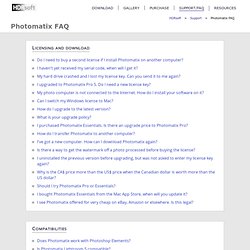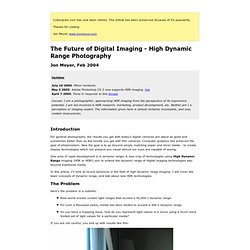

FAQ about HDR photo software Photomatix - Tone Mapping, HDR imag. I created an HDR image, why can't I save it as JPEG?

An HDR image stores color information in 32-bit precision and as such can't be directly saved in a Low Dynamic Range format such as JPEG. An HDR image in itself is not very interesting for photographers since it can't be correctly displayed on monitors and even less printed. This is why the HDR image you created from several exposures needs to be further processed for photographic use. It needs to be tone mapped so that the values of the image data fit into the limited range that your monitor can display. Once you have applied the Tone Mapping tool to your HDR image, the details in highlight and shadows captured with your multiple exposures will then become visible on screen and you will be able to save the result as JPEG (or as 16-bit TIFF image if you choose this option). My camera does not shoot RAWs. OpenEXR. How to Take HDR (High Dynamic Range) Photos » Visual Photo Guide.
In the first part we covered what an HRD photo is, now we’ll go into a basic tutorial about how to create your own HDR (High Dynamic Range) photo.

Please keep in mind that I’m very much an amateur – I just started experimenting myself so this is more of a “how to get started” type of guide. The photo shoot What you need: Camera (with ability to change exposure settings)Tripod (not required but highly recommended)Photomatix Pro ($99, but you can get it for $85 with our Photomatix coupon code ) or Photoshop CS2/CS3/CS4/CS5/CS6 with Photomatix HDR software plugins Most modern digital cameras have exposure settings so you should be able to do this even with a normal digital point and shoot camera. Lowest ISO setting (200)Aperture Priority Mode (usually a big [A] on the wheel)3 exposure settings EV 0 for the first pictureEV -2 for the second pictureEV +2 for the third picture. The Future of Digital Imaging - High Dynamic Range Photography ( Cybergrain.com has now been retired.

This article has been preserved because of it's popularity. Thanks for visiting Jon Meyer, www.jonmeyer.com Jon Meyer, Feb 2004 Updates July 16 2006: Minor revisions.May 2 2005: Adobe Photoshop CS 2 now supports HDR imaging. linkApril 7 2005: Fixes in response to this thread. Caveat: I am a photographer, approaching HDR imaging from the perspective of its expressive potential. Introduction For general photography, the results you get with today's digital cameras are about as good and sometimes better than as the results you get with film cameras. One area of rapid development is in dynamic range. In this article, I'll look at recent advances in the field of high dynamic range imaging. The Problem Here's the problem in a nutshell: Real-world scenes contain light ranges that exceed a 50,000:1 dynamic range. If you are not careful, you end up with results like this: You can see the chair but nothing out of the window. Old Solutions Here is an example from Monet.